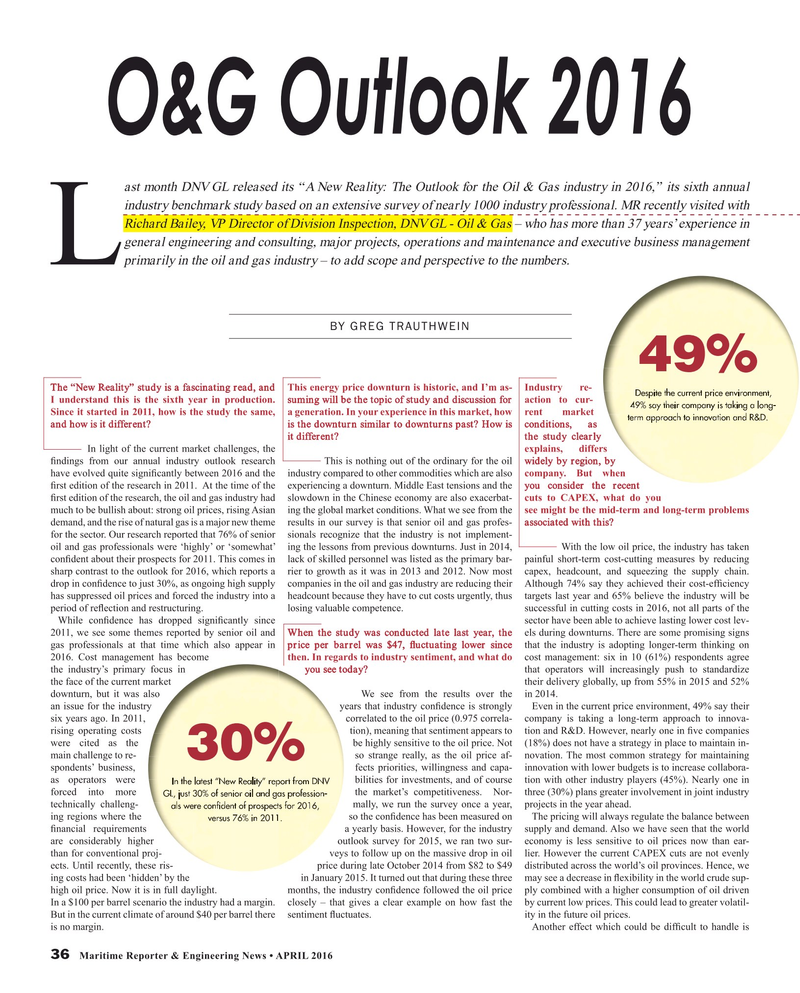
Page 36: of Maritime Reporter Magazine (April 2016)
The Offshore Annual
Read this page in Pdf, Flash or Html5 edition of April 2016 Maritime Reporter Magazine
O&G Outlook 2016 ast month DNV GL released its “A New Reality: The Outlook for the Oil & Gas industry in 2016,” its sixth annual industry benchmark study based on an extensive survey of nearly 1000 industry professional. MR recently visited with
Richard Bailey, VP Director of Division Inspection, DNV GL - Oil & Gas – who has more than 37 years’ experience in general engineering and consulting, major projects, operations and maintenance and executive business management
L primarily in the oil and gas industry – to add scope and perspective to the numbers.
BY GREG TRAUTHWEIN
The “New Reality” study is a fascinating read, and This energy price downturn is historic, and I’m as- Industry re-
I understand this is the sixth year in production. suming will be the topic of study and discussion for action to cur-
Since it started in 2011, how is the study the same, a generation. In your experience in this market, how rent market and how is it different? is the downturn similar to downturns past? How is conditions, as it different? the study clearly In light of the current market challenges, the explains, differs ? ndings from our annual industry outlook research This is nothing out of the ordinary for the oil widely by region, by have evolved quite signi? cantly between 2016 and the industry compared to other commodities which are also company. But when ? rst edition of the research in 2011. At the time of the experiencing a downturn. Middle East tensions and the you consider the recent ? rst edition of the research, the oil and gas industry had slowdown in the Chinese economy are also exacerbat- cuts to CAPEX, what do you much to be bullish about: strong oil prices, rising Asian ing the global market conditions. What we see from the see might be the mid-term and long-term problems demand, and the rise of natural gas is a major new theme results in our survey is that senior oil and gas profes- associated with this?
for the sector. Our research reported that 76% of senior sionals recognize that the industry is not implement- oil and gas professionals were ‘highly’ or ‘somewhat’ ing the lessons from previous downturns. Just in 2014, With the low oil price, the industry has taken con? dent about their prospects for 2011. This comes in lack of skilled personnel was listed as the primary bar- painful short-term cost-cutting measures by reducing sharp contrast to the outlook for 2016, which reports a rier to growth as it was in 2013 and 2012. Now most capex, headcount, and squeezing the supply chain. drop in con? dence to just 30%, as ongoing high supply companies in the oil and gas industry are reducing their Although 74% say they achieved their cost-ef? ciency has suppressed oil prices and forced the industry into a headcount because they have to cut costs urgently, thus targets last year and 65% believe the industry will be period of re? ection and restructuring. losing valuable competence. successful in cutting costs in 2016, not all parts of the
While con? dence has dropped signi? cantly since sector have been able to achieve lasting lower cost lev- 2011, we see some themes reported by senior oil and When the study was conducted late last year, the els during downturns. There are some promising signs gas professionals at that time which also appear in price per barrel was $47, ? uctuating lower since that the industry is adopting longer-term thinking on 2016. Cost management has become then. In regards to industry sentiment, and what do cost management: six in 10 (61%) respondents agree the industry’s primary focus in you see today? that operators will increasingly push to standardize the face of the current market their delivery globally, up from 55% in 2015 and 52% downturn, but it was also We see from the results over the in 2014. an issue for the industry years that industry con? dence is strongly Even in the current price environment, 49% say their six years ago. In 2011, correlated to the oil price (0.975 correla- company is taking a long-term approach to innova- rising operating costs tion), meaning that sentiment appears to tion and R&D. However, nearly one in ? ve companies were cited as the be highly sensitive to the oil price. Not (18%) does not have a strategy in place to maintain in- main challenge to re- so strange really, as the oil price af- novation. The most common strategy for maintaining spondents’ business, fects priorities, willingness and capa- innovation with lower budgets is to increase collabora- as operators were bilities for investments, and of course tion with other industry players (45%). Nearly one in forced into more the market’s competitiveness. Nor- three (30%) plans greater involvement in joint industry technically challeng- mally, we run the survey once a year, projects in the year ahead.
ing regions where the so the con? dence has been measured on The pricing will always regulate the balance between ? nancial requirements a yearly basis. However, for the industry supply and demand. Also we have seen that the world are considerably higher outlook survey for 2015, we ran two sur- economy is less sensitive to oil prices now than ear- than for conventional proj- veys to follow up on the massive drop in oil lier. However the current CAPEX cuts are not evenly ects. Until recently, these ris- price during late October 2014 from $82 to $49 distributed across the world’s oil provinces. Hence, we ing costs had been ‘hidden’ by the in January 2015. It turned out that during these three may see a decrease in ? exibility in the world crude sup- high oil price. Now it is in full daylight. months, the industry con? dence followed the oil price ply combined with a higher consumption of oil driven
In a $100 per barrel scenario the industry had a margin. closely – that gives a clear example on how fast the by current low prices. This could lead to greater volatil-
But in the current climate of around $40 per barrel there sentiment ? uctuates. ity in the future oil prices.
is no margin. Another effect which could be dif? cult to handle is 36 Maritime Reporter & Engineering News • APRIL 2016
MR #4 (34-41).indd REVISED.indd 36 4/8/2016 8:56:06 AM

 35
35

 37
37
